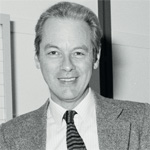Physics to help cure people
Ugo Amaldi was well known as a particle physicist at CERN when he decided to work towards promoting the creation in Europe of a network of centres for cancer therapy using beams of ions, in particular carbon ions.
 “My interest in medical physics dates back to the late 1950s, when I began to work at Italy's health institute in Rome, the ISS. I went to ISS instead of starting an academic career, because my father Edoardo, a very well known physicist and one of CERN’s founders, had been professor in Rome since 1937 and I wanted to distinguish myself from him. In ISS I did experiments in nuclear and particle physics and worked part-time in radiation physics and radiotherapy, a subject I enjoyed a lot. From 1968 to 1973 I led a group of physicists from ISS working at CERN, and then — after a successful experiment at the Intersecting Storage Rings — in 1973 I was offered a full-time staff position at CERN. One thing led to another, and by 1981 I initiated and became the spokesman for DELPHI, a major LEP experiment.
“My interest in medical physics dates back to the late 1950s, when I began to work at Italy's health institute in Rome, the ISS. I went to ISS instead of starting an academic career, because my father Edoardo, a very well known physicist and one of CERN’s founders, had been professor in Rome since 1937 and I wanted to distinguish myself from him. In ISS I did experiments in nuclear and particle physics and worked part-time in radiation physics and radiotherapy, a subject I enjoyed a lot. From 1968 to 1973 I led a group of physicists from ISS working at CERN, and then — after a successful experiment at the Intersecting Storage Rings — in 1973 I was offered a full-time staff position at CERN. One thing led to another, and by 1981 I initiated and became the spokesman for DELPHI, a major LEP experiment.
By 1991, after the first results and a much quoted paper on the supersymmetric unification of the fundamental forces, DELPHI was running very well. But it wasn't obvious to me what I should do next. I was 57 years old, and I knew I wouldn't be running experiments when the LHC came online. Still, I wanted to do something at the frontier of physics. So I decided to go back to radiation physics.
The idea of using physics to help cure people still appealed to me, so in 1991 I wrote a proposal for a cancer therapy centre based on beams of carbon ions (and of protons), a treatment modality now called ‘hadron therapy'. One year later I created the TERA Foundation to collect funds for personnel working on the design of treatment centres, also with the help from the Italian Institute for Nuclear Physics, INFN.
Then, as now, the main tool for cancer therapy was radiotherapy with X-rays, but dedicated proton centres were also being built. However, I was interested in some results obtained at the Lawrence Berkeley Laboratory and in papers written by Gerhard Kraft of GSI. About 10% of tumours treated with X-rays turn out to be resistant both to X-rays and protons, but it appeared that these stubborn tumours might respond if they were bombarded with the nuclei of carbon atoms. Each carbon nucleus leaves 24 times more energy than a proton in a cell. Carbon beams are thus effective in controlling radioresistant tumours, such as those of the brain, lung and liver.
At the end of 1995 I drew the interest of the CERN management to the design of an ion synchrotron optimized for such a medical application. This became PIMMS, the Proton Ion Medical Machine Study, on which physicists and engineers from CERN, TERA and the MedAustron project worked for four years. In parallel, with TERA I proposed that the Italian government finance a treatment centre based on an improved version of the PIMMS synchrotron, now called the PIMMS/TERA project. As the centre would cost about €70 million, this was a hard sell, but the Italian government finally put up the money in 2002. The Centre is now being built in the town of Pavia, 30 kilometres south of Milan, by the CNAO Foundation, which is composed of five large hospitals and TERA. INFN is co-responsible for the construction of the accelerator.
In 1999 I left CERN and now I teach medical physics at the University Milano Bicocca. I keep close ties to CERN, because I have started a new project (based on novel linear accelerators for hadron therapy) and CERN expertise is precious when it comes to developing new instruments.”

